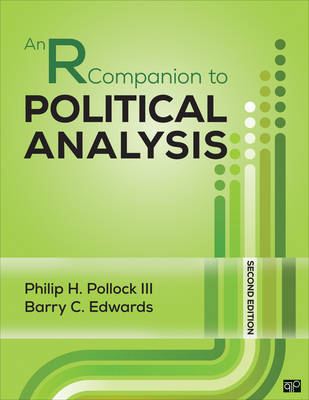
An R Companion to Political Analysis
Cq Press (Verlag)
978-1-5063-6884-9 (ISBN)
- Titel gebraucht verfügbar
- Artikel merken
"Students will love this book, as will their teachers."
– Courtney Brown, Emory University
Philip H. Pollock III is a professor of political science at the University of Central Florida. He has taught courses in research methods at the undergraduate and graduate levels for more than thirty years. His main research interests are American public opinion, voting behavior, techniques of quantitative analysis, and the scholarship of teaching and learning. His recent research has been on the effectiveness of Internet-based instruction. Pollock’s research has appeared in the American Journal of Political Science, Social Science Quarterly, and the British Journal of Political Science. Recent scholarly publications include articles in Political Research Quarterly, the Journal of Political Science Education, and PS: Political Science and Politics. Barry C. Edwards is a lecturer in the Department of Political Science at the University of Central Florida. He received his B.A. from Stanford University, a J.D. from New York University, and a Ph.D. from the University of Georgia. His teaching and research interests include American politics, public law, and research methods. He founded the Political Science Data Group and created the PoliSciData.com web site. His research has been published in American Politics Research, Congress & the Presidency, Election Law Journal, Emory Law Journal, Georgia Bar Journal, Harvard Negotiation Law Review, Journal of Politics, NYU Journal of Legislation and Public Policy, Political Research Quarterly, Presidential Studies Quarterly, Public Management Review, and State Politics and Policy Quarterly.
List of Boxes and Figures
Preface
A Quick Reference Guide to R Companion Functions
Introduction: Getting Acquainted with R
About R
Installing R
A Quick Tour of the R Environment
Objects
Functions
Getting Help
Exercises
Chapter 1: The R Companion Package
Running Scripts
Ten Tips for Writing Good R Scripts
Managing R Output: Graphics and Text
Additional Software for Working with R
Debugging R Code
Exercises
Chapter 2: Descriptive Statistics
Interpreting Measures of Central Tendency and Variation
Describing Nominal Variables
Describing Ordinal Variables
Describing the Central Tendency of Interval Variables
Describing the Dispersion of Interval Variables
Obtaining Case-Level Information
Exercises
Chapter 3: Transforming Variables
Applying Mathematical and Logical Operators to Variables
Creating Indicator Variables
Changing Variable Classes
Adding or Modifying Variable Labels
Collapsing Variables into Simplified Categories
Centering or Standardizing a Numeric Variable
Creating an Additive Index
Exercises
Chapter 4: Making Comparisons
Cross-Tabulations and Mosaic Plots
Line Charts
Mean Comparison Analysis
Box Plots
Strip Charts
Exercises
Chapter 5: Making Controlled Comparisons
Cross-Tabulation Analysis with a Control Variable
Multiple Line Charts
The legend Function
Mean Comparison Analysis with a Control Variable
Exercises
Chapter 6: Making Inferences about Sample Means
Finding the 95 Percent Confidence Interval of the Population Mean
Testing Hypothetical Claims about the Population Mean
Making Inferences about Two Sample Means
Making Inferences about Two Sample Proportions
Exercises
Chapter 7: Chi-Square and Measures of Association
Analyzing an Ordinal-Level Relationship
Analyzing an Ordinal-Level Relationship with a Control Variable
Analyzing a Nominal-Level Relationship with a Control Variable
Exercises
Chapter 8: Correlation and Linear Regression
Correlation Analysis
Bivariate Regression with a Dummy Variable
Bivariate Regression with an Interval-Level Independent Variable
Multiple Regression Analysis
Multiple Regression with Ordinal or Categorical Variables
Weighted Regression with a Dummy Variable
Multiple Regression Analysis with Weighted Data
Weighted Regression with Ordinal or Categorical Independent Variables
Creating Tables of Regression Results
Exercises
Chapter 9: Visualizing Correlation and Regression Analysis
Visualizing Correlation
General Comments about Visualizing Regression Results
Plotting Multiple Regression Results
Interaction Effects in Multiple Regression
Visualizing Regression Results with Weighted Data
Special Issues When Plotting Observations with Limited Unique Values
Exercises
Chapter 10: Logistic Regression
Thinking about Odds, Logged Odds, and Probabilities
Estimating Logistic Regression Models
Interpreting Logistic Regression Results with Odds Ratios
Visualizing Results with Predicted Probabilities Curves
Probability Profiles for Discrete Cases
Model Fit Statistics for Logistic Regressions
An Additional Example of Multivariable Logistic Regression
Exercises
Chapter 11: Doing Your Own Political Analysis
Seven Doable Ideas
Importing Data
Writing It Up
Appendix
Table A.1 Alphabetical List of Variables in the GSS Dataset
Table A.2 Alphabetical List of Variables in the NES Dataset
Table A.3 Alphabetical List of Variables in the States Dataset
Table A.4 Alphabetical List of Variables in the World Dataset
About the Authors
| Erscheinungsdatum | 06.06.2017 |
|---|---|
| Verlagsort | Washington |
| Sprache | englisch |
| Maße | 215 x 279 mm |
| Gewicht | 580 g |
| Themenwelt | Sozialwissenschaften ► Politik / Verwaltung ► Politische Theorie |
| ISBN-10 | 1-5063-6884-0 / 1506368840 |
| ISBN-13 | 978-1-5063-6884-9 / 9781506368849 |
| Zustand | Neuware |
| Haben Sie eine Frage zum Produkt? |
aus dem Bereich



